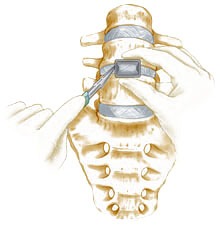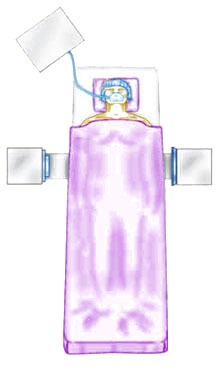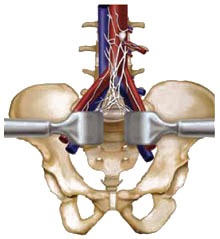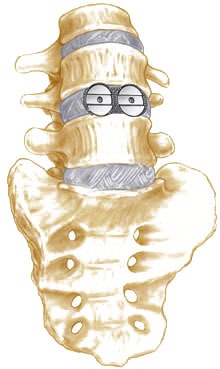ALIF - Anterior Lumbar Interbody Fusion
Anterior lumbar interbody fusion (ALIF) is a spine surgery that involves approaching the spine from the front of the body to remove disc or bone material from in between two adjacent lumbar vertebrae. The procedure may be performed either as an open surgery or using minimally invasive techniques.
What Is An ALIF?
Anterior lumbar interbody fusion (ALIF) is a spine surgery that involves approaching the spine from the front (anterior) of the body to remove all or part of a herniated disc from in between two adjacent vertebrae (interbody) in the lower back (lumbar spine), then fusing, or joining together, the vertebrae on either side of the remaining disc space using bone graft or bone graft substitute.
The graft material acts as a binding medium and also helps maintain normal disc height - as the body heals, the vertebral bone and bone graft eventually grow together and stabilize the spine. Instrumentation, such as rods, screws, plates, cages, hooks and wire also may be used to create an "internal cast" to support the vertebral structure during the healing process.
Depending on your condition and your surgeon's training, experience and preferred methodology, an ALIF may be done alone or in conjunction with another spinal fusion approach. Please discuss your fusion approach options thoroughly with your doctor, and rely on his or her judgment about which is most appropriate for your particular condition.
Why Do I Need This Procedure?
There are a number of reasons your surgeon may recommend spinal fusion. This procedure is frequently used to treat
- One or more fractured (broken) vertebrae
- Spondylolisthesis (slippage of one vertebral bone over another)
- Abnormal curvatures of the spine, such as scoliosis or kyphosis
- Protruding or degenerated discs (the cartilaginous "cushions" between vertebrae)
- Instability of the spine (abnormal or excessive motion between two or more vertebrae)
Patients with low back and/or leg pain due to degenerative disc disease, spondylolysis/spondylolisthesis, scoliosis, or other spinal instability that have not responded to non-surgical treatment measures (rest, physical therapy or medications) may be suitable candidates for an ALIF.
Patients without an excessive amount of spinal instability or slippage, and who have little to no spinal stenosis or nerve compression in the back of the spine, are generally the best candidates for an ALIF alone. However, ALIF as a stand-alone technique is usually not recommended for people whose bones have become very soft due to osteoporosis, or in patients with instability or arthritis.
Your surgeon will take a number of factors into consideration before recommending an ALIF, including the condition to be treated, your age, health and lifestyle and your anticipated level of activity following surgery. Please discuss this treatment option thoroughly with your spinal care provider.
How Is An ALIF Performed?
For an ALIF procedure, the patient is positioned on his or her back and sedated under general anesthesia. The surgeon then
- Makes an incision in the abdomen and retracts the abdominal muscles, organs and vascular structures - including such major blood vessels as the aorta and vena cava - for a clear view of the front of the spine and access to the vertebrae. (This part of the procedure may be performed by a general surgeon or vascular specialist.)
- Removes all or part of the degenerated disc(s) from the affected disc space, and inserts bone graft or bone graft substitute into the disc space between the vertebral bodies, to support the disc space and promote bone healing
- Returns the abdominal organs, blood vessels and muscles to their normal place, and closes the incision

Surgeons typically perform an ALIF as a traditional, open procedure as described above; however, another option is to access the spine using minimally invasive (endoscopic) technologies that allow surgeons to reach the affected vertebrae through small incisions and intramuscular tunnels created to accommodate special guidance, illumination and surgical tools.
How Long Will It Take Me To Recover?
The recovery period for a spinal fusion procedure such as an ALIF will vary, depending on the procedure and your body's ability to heal and firmly fuse the vertebrae together. One advantage of an ALIF is that the back muscles and nerves are undisturbed.
Patients typically stay in the hospital for several days, longer if necessary for more extensive surgery. This may also include time in a rehabilitation unit. Your surgeon will prescribe pain medication as needed, and may recommend a brace and follow-up physical therapy.
The length of time you will be off work will depend on a number of factors: your particular procedure and the physician's approach to your spine, the size of your incision, and whether or not you experienced any significant tissue damage or complications. Another consideration is the type of work you plan to return to. Typically, you can expect to be on medical leave for 3 to 6 weeks; however, many innovations and advancements have been developed in the last few years that allow for improved fusion rates, shorter hospital stays and a more active and rapid recovery period.
Work closely with your spinal surgeon to determine the appropriate recovery protocol for you, and follow his or her instructions to optimize the healing process.
Are There Any Potential Risks Or Complications?
All treatment and outcome results are specific to the individual patient. Results may vary. Complications such as infection, nerve damage, blood clots, blood loss and bowel and bladder problems, along with complications associated with anesthesia, are some of the potential risks of spinal surgery. A potential risk inherent to spinal fusion is failure of the vertebral bone and graft to properly fuse, a condition that may require additional surgery.
Please consult your physician for a complete list of indications, warnings, precautions, adverse effects, clinical results and other important medical information that pertains to the ALIF procedure.
The materials on this Web site are for your general educational information only. Information you read on this Web site cannot replace the relationship that you have with your health care professional. We do not practice medicine or provide medical services or advice as a part of this Web site. You should always talk to your health care professional for diagnosis and treatment.



